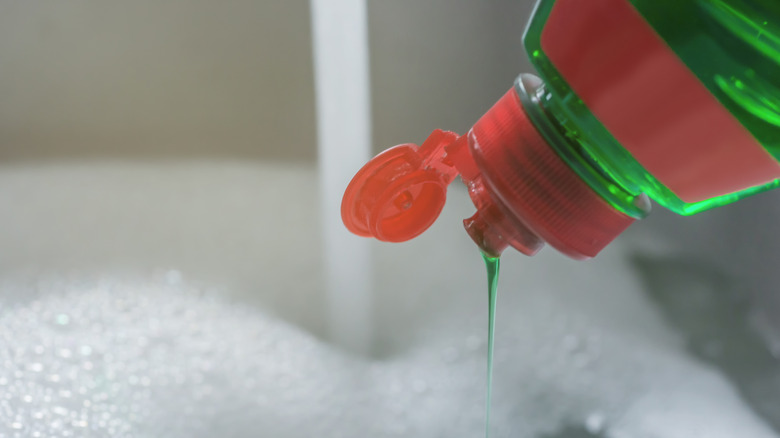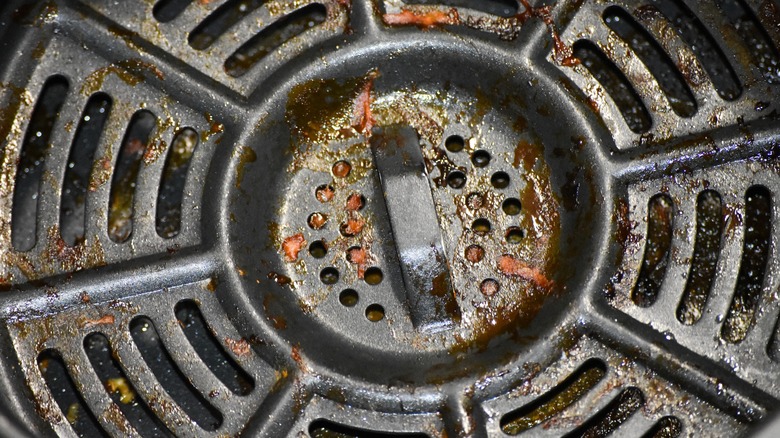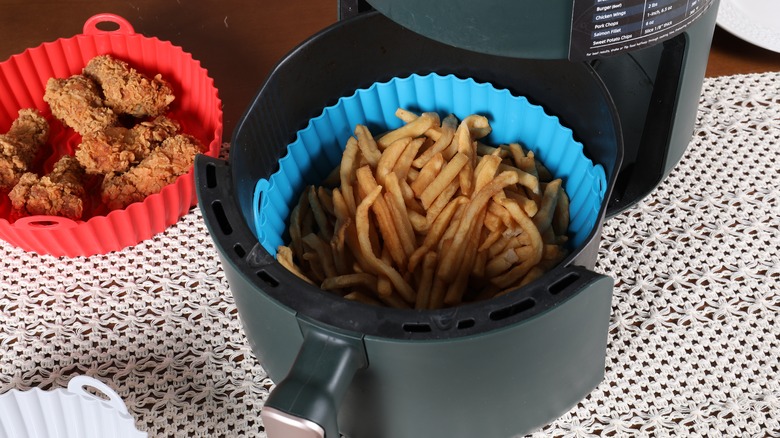Tips You Should Know When Cleaning Your Air Fryer
We may receive a commission on purchases made from links.
Air fryers are pretty nifty appliances, and for a good reason: they preheat quickly, get your food nice and crispy, and can even help you save money. These compact devices work by rapidly blowing super hot air around food. Since the food sits in a basket, the entire surface area is heated, leading to evenly heated, delightfully crispy meals. The one downside to using an air fryer is having to clean it afterward.
People use air fryers to cook all kinds of foods. Meat is a common choice, especially meat with skin like chicken drumsticks. Vegetables are popular options as well, as are eggs, bread items, and even desserts like brownies. The problem is that some of these foods can cause a huge mess in your air fryer, leading to stuck-on food, grease splatter, and sauce drips. After a delicious meal, the last thing you want to deal with is the arduous task of cleaning all the appliance's nooks and crannies. Luckily, there are a few things you can do to take the headache out of cleaning your air fryer.
Check the manual
It might sound rudimentary, but the truth is that you should always check the manuals for appliances that you buy. They will tell you how to operate and care for your purchases, and offer key troubleshooting tips and useful advice, such as where to place your air fryer in your kitchen. If you can't find your air fryer's manual, you can usually look it up online by searching for the appliance's model number.
Every air fryer is a little different, but each respective manual will go over all the various parts of your appliance. Most, but not all, air fryers include the basket where the food goes, the air fryer drawer or pan that collects grease, the heating element to cook the food, the fan to circulate the hot air, and, on the outside of the appliance, control buttons and an air inlet. However, your particular air fryer may have more parts or may not include certain parts, like the drawer.
The manual will tell you which parts of your air fryer can and can't be removed for cleaning. It will also tell you the best methods to use to clean the air fryer, how often to clean it, and steps you can take to extend the life of your appliance.
Understand that not all parts are dishwasher-safe
The dishwasher is by far the easiest way to clean dishes and cookware, but not all parts of your air fryer can be removed for dishwashing, and of those that can, not all are dishwasher-safe. Your air fryer manual should tell you if any of your parts can go in the dishwasher. Those parts may be stamped with a little symbol of two plates under a shower of water, indicating that they're dishwasher safe. However, not all appliance parts have this symbol, even if they are okay to go in the dishwasher.
In most air fryers, the basket is dishwasher-safe, and the grease drawer may be as well. Some manuals may recommend putting these parts on the top rack only. Not following these types of instructions is a common mistake people make when loading their dishwasher, and putting the air fryer parts in the wrong part of the dishwasher can damage them.
Damage to your air fryer from improper cleaning includes a chipped coating or warping. If your air fryer basket becomes warped, you may not be able to fit it back into the appliance properly. Additionally, some plastics, like what your drawer or tray may be made of, can leach chemicals in the high heat of the dishwasher, contaminating your dishes.
Clean the air fryer immediately after every use
It may sound like a pain, but you should be cleaning your air fryer every time you use it. There are a few reasons for this. First, leaving grease or stuck-on food on your air fryer parts can cause bacteria or mold to grow, which can make you ill the next time you use the air fryer. Next, leaving residue in the air fryer for multiple uses will ultimately make it more difficult to clean, and you may need to resort to more abrasive cleaning methods, which can damage the parts of your air fryer. Finally, old food or grease can be a fire hazard the next time you fire up the fryer.
You should clean your air fryer as soon as possible to prevent stubborn spots. While you eat what you've cooked, let the air fryer cool; you should never try to clean a still-warm air fryer. Then, take out the removable parts, like the basket and pan, and use a damp cloth to wipe down the inside of the appliance. Wash the removable parts either in the dishwasher or by hand and let them dry completely before putting them back.
The outside of the air fryer doesn't need to be cleaned as often — this is usually an as-needed job. The heating element or coils don't need to be cleaned every time either, but you should wipe them down every few uses.
Don't be afraid to let certain parts soak
Some air fryer baskets can't go in the dishwasher because they're coated with a nonstick surface that can be damaged. The good news is that being nonstick generally makes the baskets easier to clean, but the bad news is that if you've got a particularly tough spot, it can be hard to figure out the best way to remove it without damaging the nonstick surface.
If you grew up with parents who gave you the chore of doing the dishes every night, you may have been told that letting dishes soak was lazy. However, this practice does actually help with stuck-on food. Leaving your air fryer basket or pan soak in a hot bath with a little dish soap will soften the tough stains, making it easier to wipe away the food residue, reduce damage to your air fryer parts, and prevent the nonstick coating from coming off. The time needed to soak depends on the severity of the residue, but you can usually check the basket or pan after 10 to 15 minutes.
Use baking soda and vinegar for stubborn stains
It's the quintessential science project: a paper mache volcano and a mixture of baking soda and vinegar to create a fizzy, bubbly eruption. But the baking soda/vinegar combo is good for more than just party tricks; it's an excellent stain remover.
Individually, baking soda and vinegar are both great cleaning agents; baking soda breaks down grease and is a gentle abrasive, while vinegar can break apart minerals. When it comes to cleaning, they're even better together, as the combo can break apart tough, stuck-on foods and stains. Vinegar is an acid and baking soda is alkaline. When mixed, the chemical reaction releases carbon dioxide, which are the bubbles you see. These bubbles are excellent at loosening gunk and stuck-on food, and you won't have to worry about damaging your cookware.
To make this work, sprinkle some baking soda over the area you're trying to clean, then spray on or pour a little bit of vinegar on top. Let the two chemicals work their magic, then wipe away with a cloth or sponge and rinse. The baking soda usually isn't abrasive enough to damage nonstick coatings, but if you're concerned, use a little extra vinegar or rinse the basket first before wiping it down.
Avoid harsh chemicals or abrasive sponges
As we've mentioned a few times already, you want to avoid using anything too harsh or abrasive when cleaning your air fryer. Rough sponges or steel wool can damage your air fryer's basket or tray, while strong chemicals can eat away at the protective coating. This not only looks unsightly, but when this happens to a nonstick coating, your basket won't be so non-stick anymore.
Damage to the enamel causes food to stick to those areas, making them harder to clean, which in turn leads to using tougher methods of stain removal. A break in the coating can also make it deteriorate faster, leading to even more work when it's time to clean up. Cleaning solutions aren't the only things that do this either; using nonstick sprays on nonstick pans can damage the coating as well.
While it's only advisable not to use anything abrasive on the removable parts of your air fryer to keep it in good working order, you should never use abrasives on the heating element at all. This can cause major damage to your air fryer, making it a fire hazard that's generally not covered under warranty.
Clean the inner compartments also
We've already talked about cleaning the inside of your air fryer; that's not a suggestion, it's really a requirement. It's understandable why you may be apprehensive about cleaning it. With the electrical components inside, you likely don't want to risk damaging the appliances or getting hurt.
Of course, you shouldn't submerge your entire air fryer in water. It is still electronic, after all, and getting certain parts wet can completely destroy it. Instead, once the air fryer has cooled and you've taken out the basket, tray, and any other removable components, dip a soft washrag in hot, soapy water. Squeeze out most of the excess water and wipe the inside surface down with the rag, gently cleaning the heating coils.
If there's food or grease stuck to the heating element, you can usually use a soft-bristled brush, like a toothbrush, to remove it. Never use anything highly abrasive, like steel wire or steel wool, to clean the heating element. The damage to the coils this would cause can become a fire hazard.
Make sure the air fryer is dry before using it again
For a while, there was a viral air fryer cleaning hack going around on TikTok and YouTube that involved putting water in an air fryer and turning it on. The idea is that the heat of the air fryer will create steam, and that steam will loosen stuck-on food and make it easier to clean the inside of the appliance. However, this is not a good idea.
While a very small amount of water probably won't damage your air fryer, if that water were to get into the electrical components, it could seriously ruin your device. Air fryers are not designed to heat water, and generally, you should keep liquids of any kind far away from the air fryer. On top of potentially damaging the electronics within your appliance, the heated water could splatter or spill, causing burns or other injuries. You also risk the possibility of electrocuting yourself. Skip the trendy TikTok hacks and follow your manual's guide for cleaning instead.
Use parchment paper or liners for even easier clean-up
If you're anything like us, you're not a big fan of doing dishes. Parchment paper can be a lifesaver in that regard, especially since, as we mentioned, you shouldn't use nonstick spray on your appliance. Parchment paper is commonly used to line most baking sheets and pans, and when you're done cooking, you simply throw it away with all the mess contained. There are also tons of other parchment paper cooking hacks, including — surprise, surprise — using parchment paper to line the basket of your air fryer. Simply cut the paper to size, slip it inside the basket, then add the food you plan to fry.
Several companies also sell air fryer liners. These may be made of silicon or parchment-type paper that's pre-cut to fit neatly into the basket of an air fryer. Some brands have small holes in their liners to allow for better airflow, which ensures that even with the liner, your food heats evenly and becomes nice and crispy. You can use parchment paper or liners any time you use the air fryer, but it's especially great for items that are messy or greasy, or even foods that are totally unexpected.









